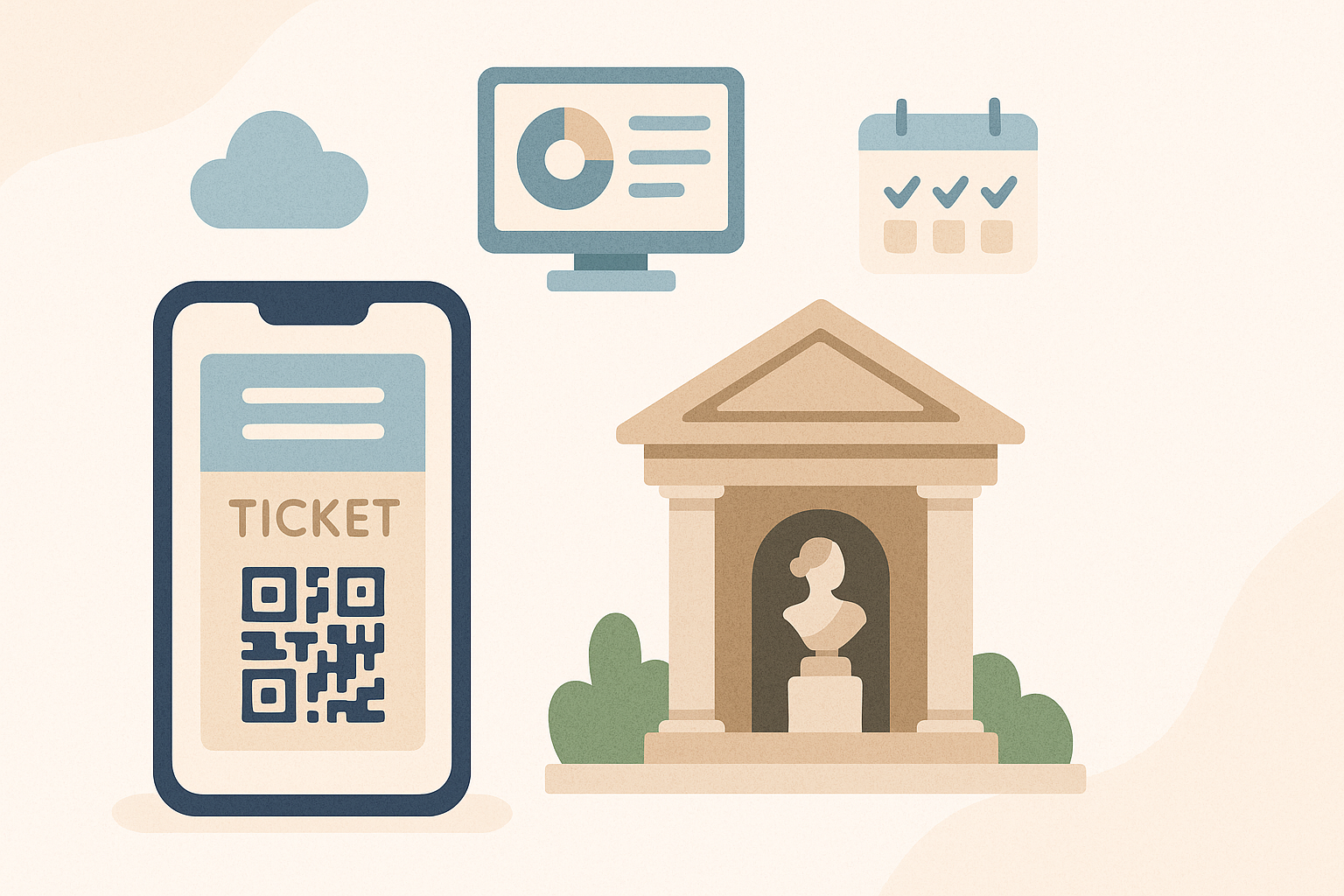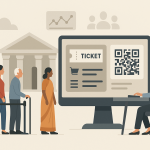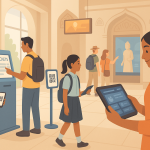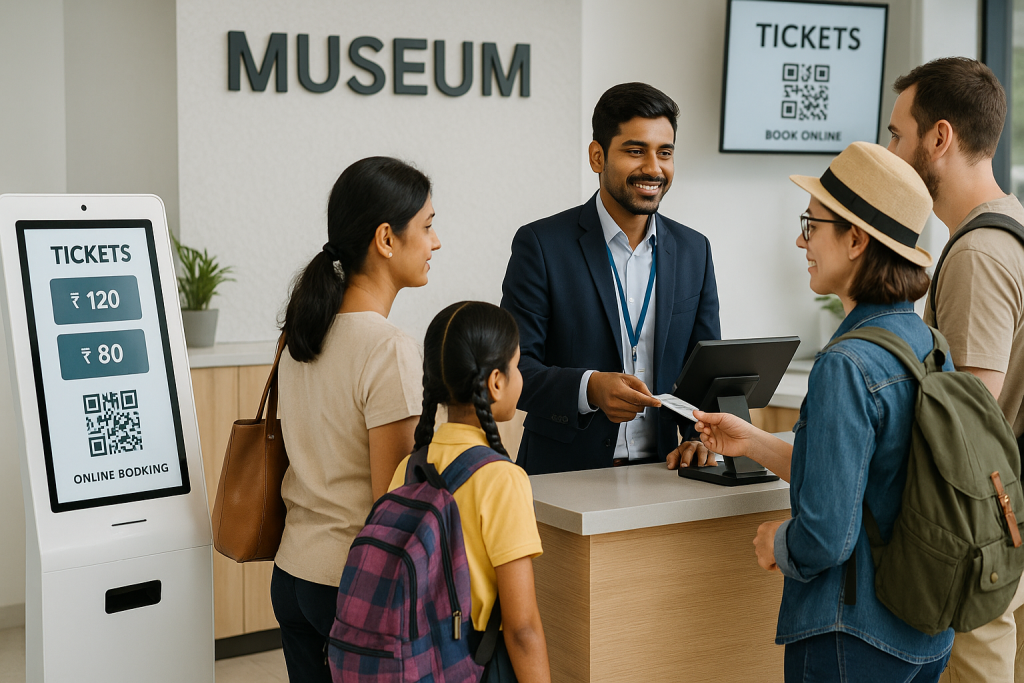Ticketing online for a small museum is no longer a luxury, it’s a necessity. Small museums often deal with long queues, lost tickets, no visitor records, and cash-handling issues. Without proper systems, it’s hard to track footfall, prevent fraud, or plan for busy days.
But there’s a better way. Online museum ticketing has become simple and affordable even for the smallest institutions. With the right tools, you can handle bookings, manage entries, and get real-time visitor data from your phone or laptop.
The global online event ticketing market is projected to reach USD 89.44 billion by 2030, growing at a 6% CAGR, with demand driven by convenience and the shift to mobile booking platforms
Digital ticketing for museums isn’t just for big city galleries anymore. Small museum ticket management is now easier, faster, and more reliable. And yes, you can set it up without any technical skills.
What challenges do small museums face with manual ticketing?
Running ticketing manually may seem simple, but it creates hidden problems that grow over time. For many small museums, these issues slow down daily operations and limit growth.
Inconsistent records are common when tickets are handwritten or logged in notebooks. It’s easy to misplace entries or make errors during busy hours.
Without a museum entry management system, there’s no real-time data to show how many visitors entered today, or how many more are expected.
Manual processes also increase the risk of fraud and duplicate entries, especially when using paper tickets or stamps.
During weekends or holidays, visitors often face long wait times, which affects their experience and reduces walk-ins.
And perhaps most importantly, it becomes difficult to track footfall and revenue accurately making it hard to report to trustees, funders, or government departments.
These challenges may seem small at first but can add up quickly. That’s why more small museums are now moving toward digital solutions.
Can a small museum use an online ticketing system?
Absolutely. Online museum ticketing is no longer limited to large institutions with big budgets. Today, even a small museum can set up a digital ticketing system without hiring a tech team or buying expensive hardware.
There are affordable, easy-to-use solutions designed specifically for small spaces. These systems run on the devices you already have like smartphones, tablets, or a basic desktop.
With a web-based dashboard, you can manage everything from ticket bookings to visitor check-ins. And with mobile-ready interfaces, your team can handle entry, track visitors, and view reports all in real time.
A small museum online ticket system helps you save time, reduce errors, and offer a better experience to your visitors. It’s a smart upgrade with long-term benefits.
What does a digital museum ticketing system do?
A digital ticketing system for museums takes care of all your entry and booking tasks in one place. It’s like having a smart assistant that works 24/7.
It starts with creating QR-based or virtual tickets. Visitors can book online, receive a QR code instantly, and simply scan it at the entrance, no paper needed.
The system also manages bookings directly from your website, social media, or an on-site kiosk. This makes it easy for both walk-in and online visitors to get tickets without delays.
It tracks every visitor and payment, so you always know how many people came in, how they paid, and what your revenue looks like.
You also get daily, weekly, or monthly reports perfect for planning, reporting to trustees, or improving operations over time.
With the right museum ticketing solutions, everything runs smoother, faster, and with fewer errors.
How can I start online entry management for my museum?
Getting started with online entry management for museums is easier than most people think. You don’t need to be tech-savvy, and you don’t need a big team. Just follow these simple steps:
Step 1: Pick a museum ticketing software
Choose a platform built for small museums. Look for one that offers online bookings, QR-code entry, and basic visitor tracking.
Step 2: Set entry time slots and pricing
Decide how many visitors you can handle per time slot. Add your ticket prices including any free or discounted categories.
Step 3: Add your museum info and bank details
Upload your museum name, address, photos, and payment details. This helps set up your booking page and ensures smooth online payments.
Step 4: Share booking link or set up a counter kiosk
You can let visitors book through a link on your website, a QR code at the gate, or directly at a digital kiosk on-site.
Step 5: Track and manage everything from your phone or PC
Use your dashboard to see daily bookings, check-ins, payments, and visitor numbers in real time.
When you manage tickets for your museum online, everything becomes faster, simpler, and more organized even for a small team.
Is it expensive or hard to maintain?
Not at all. Most museum ticket reservation systems are built to be simple and budget-friendly especially for small institutions.
Many platforms charge a small monthly fee or a per-ticket commission, making it easy to get started without large upfront costs. You only pay for what you use.
There’s no need for a tech team or complex installations. The system runs in your browser or mobile device, just like using email or WhatsApp.
Staff training is quick and simple. In most cases, your team can learn the full system in under an hour.
Once live, the benefits are clear. You save time, reduce manual errors, prevent ticket fraud, and get better control over your revenue and reports.
If you’re focused on small museum ticket management, going digital is one of the easiest upgrades you can make.
Can visitors easily book online?
Yes, booking tickets online is simple for your visitors even for those who aren’t very tech-savvy.
They can scan a QR code at the entrance, visit a booking link shared on your website or social media, or book directly on-site through a digital kiosk or counter staff.
Payments are easy too. The system supports UPI, debit cards, credit cards, and net banking, so visitors can pay using the method they prefer.
Once the booking is done, they receive an instant confirmation with a QR ticket sent via SMS, WhatsApp, or email. No printing required.
With a virtual museum ticket system, your visitors enjoy a faster, smoother experience and you spend less time managing queues and payments.
What are the benefits of going digital?
Switching to digital ticketing for museums brings immediate improvements both for your team and your visitors.
You get real-time visitor tracking, so you always know how many people are inside, how many tickets were sold, and what your revenue looks like.
Planning for holidays, school visits, or special events becomes easier with accurate footfall data. You can adjust timings, staff, and ticket limits based on actual trends.
There’s also less cash handling, which reduces mistakes and keeps transactions more secure. Visitors pay online, and you get the money directly in your bank account.
Need to send updates to trustees or government bodies? With museum ticketing software, you can download daily reports in seconds, no more manual logbooks.
And best of all, your visitors enjoy shorter wait times and smoother entry, making them more likely to return or recommend your museum to others.
What’s Your Way Forward!
Going digital isn’t just for big city museums anymore. Today, small museums across India are switching to online ticketing to improve their operations and visitor experience.
It’s simple, affordable, and easy to manage even with a small team. You don’t need technical skills, special hardware, or a large budget. Just a few clicks, and your museum is ready to offer fast, secure, and trackable ticketing.
From shorter queues to better data, the benefits are clear. And getting started takes less than a day.
Want to see how it works? Request a free demo today by filling the inquiry form.
We’re here to help you every step of the way.



